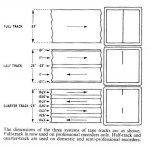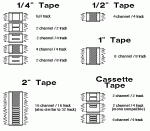miroslav
Cosmic Cowboy
The common way of referring to 1/4" and 1/2" tape track format options is:
Full Track, Half Track and Quarter Track...but that sometimes confuses people when talking about stereo recordings...like a 2-channel/2-track would be referred to as 2-track 1/2-track...or a 4-channel/2-track would be 2-track 1/4-track.
Full track is mono, one track, the full width.
Here's some images that show it:


Full Track, Half Track and Quarter Track...but that sometimes confuses people when talking about stereo recordings...like a 2-channel/2-track would be referred to as 2-track 1/2-track...or a 4-channel/2-track would be 2-track 1/4-track.
Full track is mono, one track, the full width.
Here's some images that show it:


